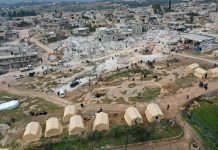
A staggering 15.3 million people require humanitarian assistance throughout Syria, representing nearly 70 per cent of the country’s population, said Ghada Eltahir Mudawi, deputy director of the Operations and Advocacy Division at the United Nations Office for the Coordination of Humanitarian Affairs (OCHA).
“For the first time in the history of the crisis, people across every sub-district in Syria are experiencing some degree of humanitarian stress,” Mudawi said at a briefing to the UN Security Council held on May 30.
According to Mudawi, earthquakes that hit Turkey in early February compounded the already bleak humanitarian situation, with more than 330,000 people displaced in Syria.
Border crossings have been a vital complement of the UN’s massive cross-border assistance operation, said Mudawi, adding that some 2,330 trucks loaded with aid from seven UN agencies have crossed into northwest Syria since the earthquakes struck.
A 7.8-magnitude earthquake that struck near the Turkish city of Gaziantep – home to around 2 million people and on the border with Syria – as people were sleeping on Monday was followed by dozens of aftershocks, including a 7.5-magnitude temblor that jolted the region in the middle of search and rescue efforts the same day.
The Syrian leader, Bashar al-Assad, agreed to open two border crossing points for three months to allow in a greater volume of emergency aid for victims of the earthquakes.
The three-month period expired in mid-May, and the Syrian government extended it until August 13.
“The preliminary Syria Earthquake Recovery Needs Assessment has estimated almost $9 billion in damage and losses, and $14.8 billion in recovery needs over the next three-year period,” Mudawi said.
The OCHA said in a statement in February that UN humanitarian agencies would need $397.6 million in funding for the following three months to respond to the most pressing humanitarian needs of 4.9 million people in Syria who have been affected by the devastating earthquakes.














